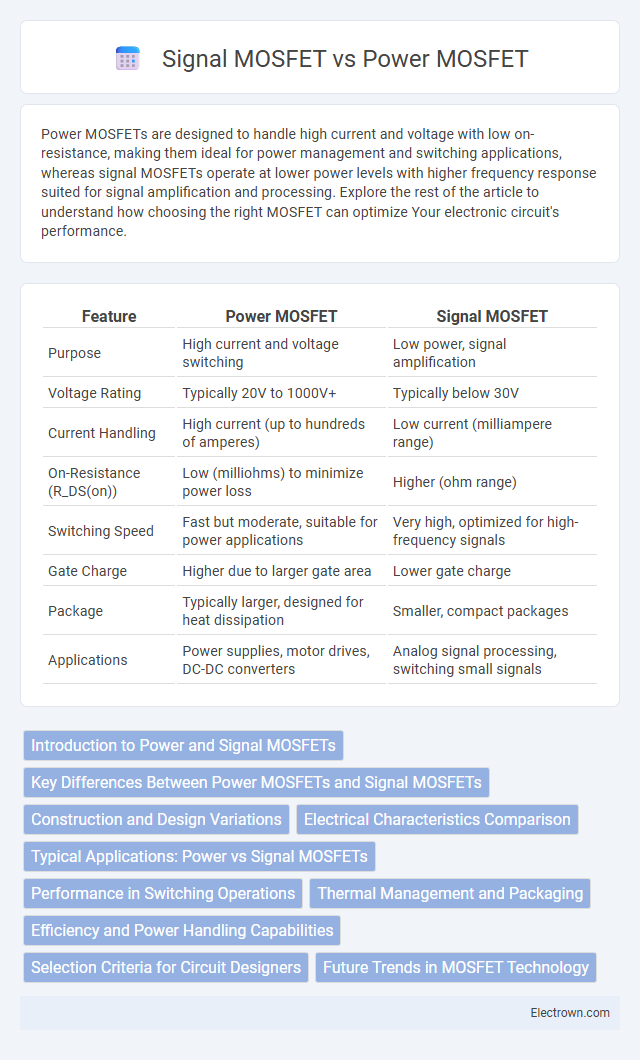Power MOSFETs are designed to handle high current and voltage with low on-resistance, making them ideal for power management and switching applications, whereas signal MOSFETs operate at lower power levels with higher frequency response suited for signal amplification and processing. Explore the rest of the article to understand how choosing the right MOSFET can optimize Your electronic circuit's performance.
Table of Comparison
| Feature | Power MOSFET | Signal MOSFET |
|---|---|---|
| Purpose | High current and voltage switching | Low power, signal amplification |
| Voltage Rating | Typically 20V to 1000V+ | Typically below 30V |
| Current Handling | High current (up to hundreds of amperes) | Low current (milliampere range) |
| On-Resistance (R_DS(on)) | Low (milliohms) to minimize power loss | Higher (ohm range) |
| Switching Speed | Fast but moderate, suitable for power applications | Very high, optimized for high-frequency signals |
| Gate Charge | Higher due to larger gate area | Lower gate charge |
| Package | Typically larger, designed for heat dissipation | Smaller, compact packages |
| Applications | Power supplies, motor drives, DC-DC converters | Analog signal processing, switching small signals |
Introduction to Power and Signal MOSFETs
Power MOSFETs are designed to handle high current and voltage levels in applications such as power supplies, motor drives, and switching regulators, featuring low on-resistance and high efficiency. Signal MOSFETs, also known as small-signal MOSFETs, are optimized for low power, high-frequency switching in analog and digital circuits, offering rapid switching speeds and minimal gate charge. The key differences lie in their construction and performance characteristics tailored to power handling versus signal amplification or switching.
Key Differences Between Power MOSFETs and Signal MOSFETs
Power MOSFETs are designed to handle high voltage and current, featuring low on-resistance (R_DS(on)) and high power dissipation capacity, making them ideal for switching and amplification in power electronics. Signal MOSFETs operate at lower voltages and currents with higher input impedance and faster switching speeds, optimized for small-signal amplification and low-power applications. Understanding these key differences helps you select the proper MOSFET type for efficient circuit design and performance.
Construction and Design Variations
Power MOSFETs feature a vertical structure with a thick drift region to handle high voltage and current, emphasizing low on-resistance and efficient heat dissipation. Signal MOSFETs are designed with lateral structures optimized for low gate charge and capacitance, ensuring high-frequency switching performance in low-power applications. The construction differences directly influence their electrical characteristics, with power MOSFETs prioritizing robustness and signal MOSFETs focusing on fast switching and minimal signal distortion.
Electrical Characteristics Comparison
Power MOSFETs feature higher current handling capabilities, lower on-resistance (R_DS(on)), and higher voltage ratings, making them suitable for switching and power management applications. Signal MOSFETs exhibit lower capacitance and gate charge, optimized for high-frequency switching and low-power signal amplification. Electrical characteristics like gate threshold voltage (V_GS(th)) tend to be more consistent and tightly controlled in signal MOSFETs, whereas power MOSFETs prioritize robustness and thermal performance.
Typical Applications: Power vs Signal MOSFETs
Power MOSFETs are commonly used in high-current applications such as power supplies, motor controllers, and DC-DC converters due to their capability to handle large voltages and currents with low on-resistance. Signal MOSFETs, on the other hand, are designed for low-power, high-frequency applications such as analog switches, digital circuits, and RF amplifiers, where fast switching and minimal gate charge are critical. Your choice between power and signal MOSFETs should be guided by the specific voltage, current, and switching speed requirements of your electronic design.
Performance in Switching Operations
Power MOSFETs offer superior performance in switching operations due to their low on-resistance (R_DS(on)) and high current handling capability, enabling efficient energy transfer with minimal power loss. Signal MOSFETs are designed for low voltage, low current applications with higher switching speeds but limited power capacity, making them ideal for signal processing rather than power delivery. Your choice depends on whether you need optimized efficiency for high-power circuits or fast switching for small signal applications.
Thermal Management and Packaging
Power MOSFETs feature advanced thermal management solutions including larger die sizes and integrated heat sinks to handle higher power dissipation, while signal MOSFETs typically have smaller die sizes with limited thermal capabilities due to their low power applications. Packaging for Power MOSFETs often involves robust materials like TO-220 or D2PAK packages designed for efficient heat transfer and mechanical durability. Signal MOSFETs use compact packaging such as SOT-23 or SOIC, optimized for low capacitance and minimal parasitic inductance rather than high thermal conductivity.
Efficiency and Power Handling Capabilities
Power MOSFETs are designed with larger die sizes and lower on-resistance (R_DS(on)) to handle high currents and dissipate heat efficiently, making them ideal for high-power applications. Signal MOSFETs prioritize low capacitance and fast switching suitable for low-power, high-frequency signal processing but have limited power handling capabilities. Your choice should align with the need for efficiency in power delivery versus precision in signal amplification.
Selection Criteria for Circuit Designers
Power MOSFETs are ideal for high-current and high-voltage applications due to their low on-resistance and high efficiency, making them suitable for power management and motor control circuits. Signal MOSFETs, designed for low-voltage, low-current applications, offer higher input impedance and faster switching speeds, essential for analog signal processing and high-frequency switching. Your selection criteria should prioritize current handling, switching speed, and thermal performance to ensure optimal circuit reliability and efficiency.
Future Trends in MOSFET Technology
Power MOSFETs are evolving with advancements in wide bandgap materials like silicon carbide (SiC) and gallium nitride (GaN), offering higher efficiency and thermal performance for high-power applications. Signal MOSFETs continue to improve with scaling down to nanometer processes, enabling lower on-resistance and faster switching speeds crucial for compact high-frequency circuits. Your choice between Power MOSFET and signal MOSFET will depend on the balance between power handling and signal integrity required in future semiconductor designs.
Power MOSFET vs signal MOSFET Infographic

 electrown.com
electrown.com